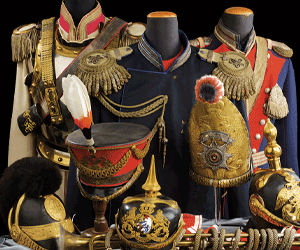House Order of Saxe-Ernestine, Type I, Military Division, I Class Commander Cross
SKU: 01.SXD.0101.203.01
Estimated market value:

Estimated market value:
Attributes
Physical Description
A Maltese cross, constructed of gold and enamel. On top of the 12 o’clock arm is a mobile golden crown, attached by two curved links. The cross is enamelled in white with a narrow golden border and golden ball finials at the tips of the cross arms. In between the cross arms are golden lions. The 12 o’clock arm features a golden letter ‘F’. The obverse centre medallion is golden and pebbled. It features the left-facing portrait of Ernest the Pious. The medallion ring is enamelled in blue with the golden inscription ‘FIDELITER ET CONSTANTER’ (‘loyal and steadfast’), with a small six-sided star at the bottom. The medallion is surrounded by an oak leaf wreath enamelled in green with golden ribbons. The reverse is similar, except that the centre medallion features five horizontal black bars on pebbled gold, with a superimposed green enamelled diagonal bar with five rue leaves with golden borders. The medallion ring features the date ‘D. 25. DECEMBER 1833’ with three small golden stars at the bottom, the one in the middle being the largest of the three. The decoration features crossed swords through the centre. If the decoration was awarded during times of war, it featured a laurel wreath rather than an oak leaf wreath. On a loop for suspension, on a purple ribbon with green side stripes.
History
The House Order of Saxe-Ernestine was jointly founded by Duke Ernst I of Coburg-Gotha, Duke Friedrich of Altenburg, and Duke Bernhard Erich Freund of Saxony-Meiningen.
This order originally consisted of the grades of Grand Cross with Grand Cross Breast Star, I Class Commander Cross with I Class Commander Breast Star, II Class Commander Cross, Knight Cross, and Silver Merit Cross.
It was awarded to members of the aforementioned families, civil servants, citizens of Coburg-Gotha, Altenburg, and Meiningen, and foreign citizens to recognise valuable and loyal services.
To be officially conferred upon a foreigner, the award had to have been supported by at least two duchies.
The awards conferred upon citizens of the three founding duchies feature an oak wreath surrounding the centre medallion, while the awards conferred upon foreigners do not.
Additionally, the order awards were decorated with a letter on the obverse of the upper cross arm that was associated with the awarding Duchy.
The order awards from Altenburg feature the letter "F" on the obverse.
The order awards from Saxony-Meiningen feature the letter "B" on the obverse.
The order awards from Coburg-Gotha feature the letter "E" on the obverse.
In 1850, the order was amended to allow crossed swords, through the centre of the cross or on the surmounting ring, to be added to the awards conferred to recognise wartime merits.
The I Class Commander Cross was identical to the II Class Commander, the only difference between the two grades was that the I Class Commander Cross was awarded with an associated I Class Commander Breast Star.

Versions
$8,500 USD
Gold/Enamelled
Obv: F FIDELITER ET CONSTANTER Rev: D 25 DECEMBER 1833
58x88mm
$8,500 USD
Gold/Enamelled
Obv: B FIDELITER ET CONSTANTER Rev: D 25 DECEMBER 1833
58x88mm
$8,500 USD
Gold/Enamelled
Obv: E FIDELITER ET CONSTANTER Rev: D 25 DECEMBER 1833
58x88mm
$8,500 USD
Gold/Enamelled
Obv: F FIDELITER ET CONSTANTER Rev: D 25 DECEMBER 1833
58x88mm
$8,500 USD
Gold/Enamelled
Obv: B FIDELITER ET CONSTANTER Rev: D 25 DECEMBER 1833
58x88mm
$8,500 USD
Gold/Enamelled
Obv: E FIDELITER ET CONSTANTER Rev: D 25 DECEMBER 1833
58x88mm


Comments
Sign in to comment and reply.


Scroll Top